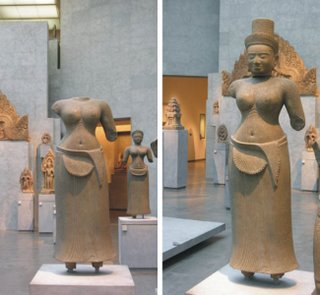History and happenstance
I took a deep breath when I read this story from the Independent newspaper in the UK a couple of years ago but its worth repeating here. How many heads and other priceless Khmer works of art are in the hands of privileged private collectors like John Gunther Dean? It reminded me of the time when I saw a Jayavarman VII head on the windowsill of an elderly gentleman in Cheltenham who used to work for the Michelin rubber company in Kompong Cham and was given the head by the curator of the National Museum in Phnom Penh as a leaving gift. He assured me it was an original and at the time, probably twenty years ago, who was I to argue. How much more of Cambodia's priceless heritage has been given away so recklessly? Here's the story by John Lichfield in Paris from May 2006.
By sheer chance
A wife of the Hindu god Shiva, decapitated in Cambodia in the 15th century, finally has her head back, after it was discovered 500 years later on the other side of the world. A Paris museum dedicated to Asia, the Musée Guimet, is celebrating the implausible chain of events that reunited a divided masterpiece of ninth-century Cambodian art. The headless body of a wife of the Hindu god of destruction and renewal was found by French archaeologists near the shattered temple of Bakong, amid the celebrated Angkor ruins, in 1935. The statue has been exhibited since 1938 at the Musée Guimet in the Place d'Iéna in Paris, which has the finest collection of ancient Khmer artefacts outside Cambodia. Last autumn, the museum held an exhibition on Vietnamese art which paid tribute in its catalogue to a retired American diplomat, John Gunther Dean. The catalogue recounted Mr Dean's efforts, as ambassador to Cambodia in the early 1970s, to rescue ancient Khmer art from the ravages of the Khmer Rouge, which was determined to expunge all record of Cambodia's past.
To thank the museum, Mr Dean, now 80, offered a gift from his own collection of ancient Khmer artefacts. Last month, the gift arrived, the sculpted head of a woman found at the Bakong temple site in 1939. "I asked him for a Khmer head because we only had headless statues but I didn't think for a moment about a possible match," said Pierre Baptiste, the museum's curator for south-east Asian art. "I brought the head into our [Cambodian] hall looking for a place that it could be exhibited," said Baptiste. "I had a sudden notion the two pieces resembled each other but then thought, 'no, things never happen that way'. I put the head on the statue's shoulders. It shifted a few millimetres. I heard the little click that you get when two stones fit together and the head fell perfectly into place. It was as if it had put itself together. I still get goose-bumps thinking about it." The reformed statue, which is 4ft 10in high, was beheaded in the temple when it was destroyed in the 15th century.
Note: The wife of Shiva is Parvati, also known as Uma. However, the Guimet Museum has always shied away from confirming the statue as a wife of Shiva, instead terming the work of art as a female divinity from the Preah Ko period, c 881.
To thank the museum, Mr Dean, now 80, offered a gift from his own collection of ancient Khmer artefacts. Last month, the gift arrived, the sculpted head of a woman found at the Bakong temple site in 1939. "I asked him for a Khmer head because we only had headless statues but I didn't think for a moment about a possible match," said Pierre Baptiste, the museum's curator for south-east Asian art. "I brought the head into our [Cambodian] hall looking for a place that it could be exhibited," said Baptiste. "I had a sudden notion the two pieces resembled each other but then thought, 'no, things never happen that way'. I put the head on the statue's shoulders. It shifted a few millimetres. I heard the little click that you get when two stones fit together and the head fell perfectly into place. It was as if it had put itself together. I still get goose-bumps thinking about it." The reformed statue, which is 4ft 10in high, was beheaded in the temple when it was destroyed in the 15th century.
Note: The wife of Shiva is Parvati, also known as Uma. However, the Guimet Museum has always shied away from confirming the statue as a wife of Shiva, instead terming the work of art as a female divinity from the Preah Ko period, c 881.



0 Comments:
Post a Comment
<< Home